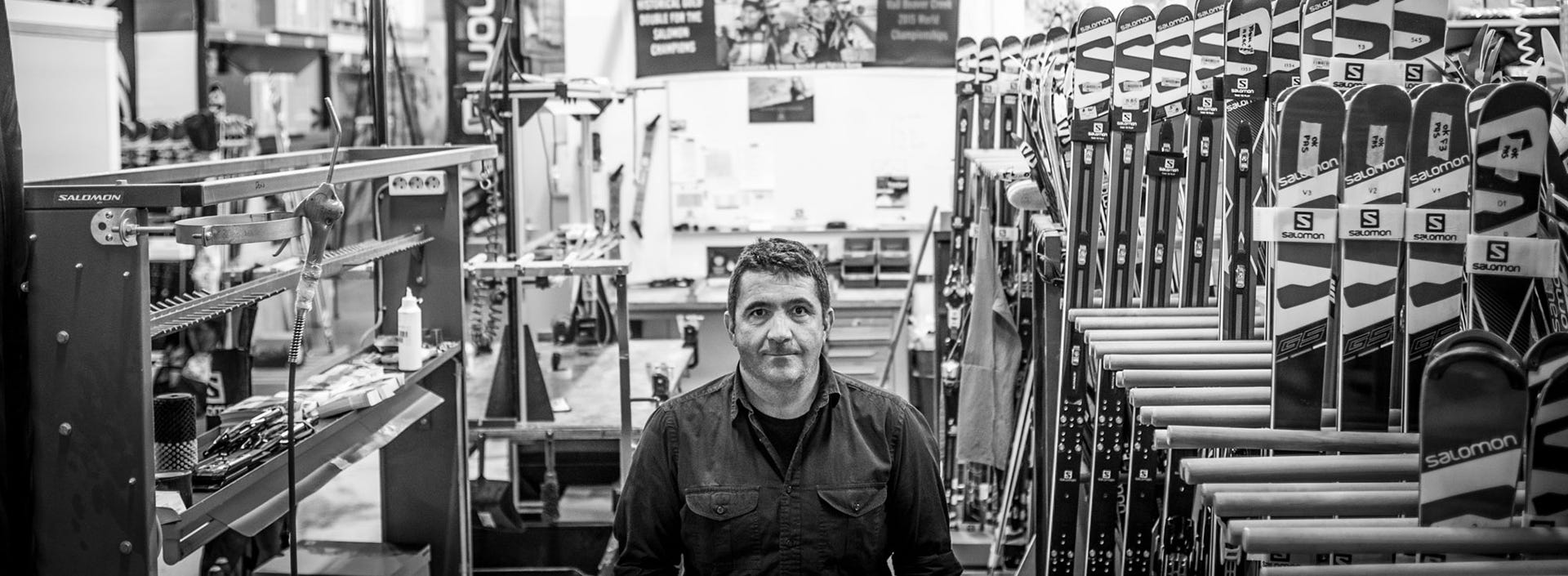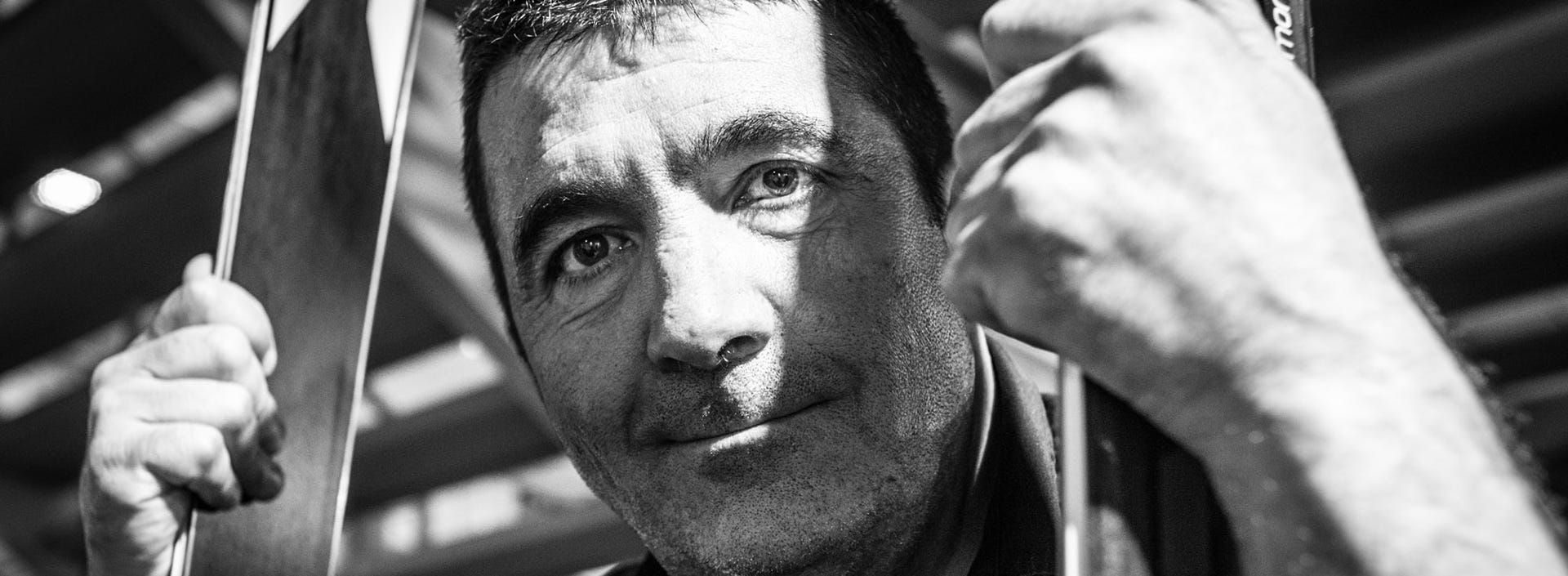It’s probably an understatement to say Bruno Bertrand is a ski enthusiast. A mountaineer whose mind is constantly gliding somewhere. A born competitor, this native of Serre-Chevalier, France has been skiing for a half century. He’s had several lives, but each required skis on his feet. Racer, mogul skier on the French national team, ski magazine director, and, for the last 16 years, a sports marketing manager at Salomon who works closely with the company’s athletes. Spending an hour with “BB” is like lifting a corner of the veil on the history of skiing. So Guillaume Desmurs did just that.
IT ALL STARTED…
At Serre-Chevalier. My dad was a mountain guide and I was pretty good on the skis. I was really into the competition and I also loved skiing. I climbed inter-regional, district, then regional alpine skiing and was at the gates of the French national team. I was part of the generation Alphand, Piccard, Rey, Cretier, but I did not pass the selections at 16 years old. So, to continue skiing, I went to see my friends doing moguls. I had a real affinity with this discipline. I liked to battle, improvise, and there was a little more freedom than in slalom. With my technical background, I found myself quickly among the good ones. In addition, the discipline was exploding. We were in the late ’80s, so it was the perfect moment. I experienced the great times of the discipline: the races were broadcast live on television and we were stars in the United States. I spent ten years with the French national team, in the world top-10, and for five seasons I was in the world top-6.
THE 1992 OLYMPICS IN ALBERTVILLE WAS...
A great pressure and a greater disillusion. We were a super strong team and I did not pass the qualifications. I only could taste the Olympics—the privilege of living it from the inside, but I did not race. That same year I finished 4th at the World Championships. It's frustrating! It was the time when France was the strongest, with five French skiers in the world's seven best. In 1995, I stopped skiing moguls. I decided to stop at age 30 before I was forced to quit. It's very difficult to leave when you're a competitor. Overnight, you get stripped of your reason for living because you have spent your life in competitions. It is your job, it’s your place in society, where your friends are, where you are recognized as an expert. It was the most difficult decision I have ever made. But I made this decision because in my long career, I saw guys being fired brutally, with a lot of frustration. In fact, I have buddies fired from the French national team who never skied again, and others who committed suicide. Stopping the competition wreaks havoc, so I decided it myself.
AFTER SKIING MOGULS, YOU BECOME...
A snowboarder! I was already snowboarding as soon as the mogul competition season ended, in mid-March. My brother and I were building boards out of plywood by putting water in the bathtub to shape the wood. We even imagined one of the first snowboard bindings, marketed by Emery, which was the reference at the time. But my new real job was editor-in-chief of Skieur Magazine. My brother was already editor-in-chief of the magazine Snowsurf, at the same publisher, Nivéales Editions. The transition between competition and journalism was fast: the last race of my career took place in La Clusaz, on March 5, a Sunday. On Monday I was in Grenoble installing my office. I did the magazine with Eric Berthon (another top mogul skier) from 1995 to 2000. I arrived with the beginnings of parabolic skiing and left with the beginning of the rocker on wide skis. The magazine quickly became the benchmark for new trends in skiing.
THEN YOU JOINED SALOMON TO BE...
Responsible for sports marketing. And still am! I was responsible for communication and marketing of the sport: managing the team of athletes, producing content, advertising, competition. Today, my job is more strategic. It is about managing sport in relation to products and service to athletes. I also handle content, such as SalomonTV (formerly FreeskiTV), and partnerships with magazines, brands, and festivals. To sum it up: I give the keys to understanding the sport to the brand, to ensure that the brand is aligned and faithful (in terms of image) with the reality of sport (trends, products, communities, skiing ). I am the interface that brings back what happens on the ground and translates it into content and products so that Salomon remains an authentic brand in the sport.


CAN YOU GIVE US SOME EXAMPLES OF HOW THAT WORKS?
Skicross. The potential of this discipline had been identified. We created the governing body before the FIS (the equivalent of the World Cups were, at the time, the Saab-Salomon Crossmax series). And the story went all the way to the Olympics! Another example: FreeskiTV. This web series has revolutionized the tone and format of ski videos. And it's been going on for ten years. Without being pretentious, I think we brought something new. It's a real know-how that we built with Canada's Mike Douglas, who is both pro-skier and producer.
THE EVOLUTION OF SKIING, YOU SEE IT AS…
A cycle that is always the same. The common base is to slide down the mountain, and within it you can find opposing tendencies: traditional inspirations and revolutionary inspirations. Among the conservative tendencies, there is racing, which has existed since 1905. It will always be there. On the other hand, innovative trends seek to break the rules. At all times, these two contradictory tendencies are in play within the skiing world.
Take skier Stein Erickson, for example. After a gold medal at the Olympic Games in 1952, he went to the U.S. to innovate the ski and launch freestyle, which took ten years to take off and get into the Olympics. This pioneering spirit was lost when the discipline entered the conservative rules of the FIS in the 1990s. Meanwhile, Californian amateurs were riding what we call now a snowboard, which was born out of a rejection for the traditional ski. Snowboarding eventually fed the changes of the new school freestyle skiers in the 1090s, which climbed until the 2014 Olympics, and has fallen now.
It is up to us to find the next step of skiing, or rather the young ones’ responsibility because they decide what the sport will be tomorrow. The creative spirit is reborn when people break the rules or step outside what is the expected norm. Stein Eriksen, Jake Burton, Henri Authier, JP Auclair and his friends, Bode Miller, Alberto Tomba and Shane McConkey have shown the way at different times. Young people are very creative on kickers. They are artists, mixing freestyle and freeride, developing their own personal expression from top to bottom.
I remember being in a lodge in Alaska, with Dominique Perret—a more conservative Swiss skier, with his giant two-meters skis—and Shane McConkey—a very progressive American skier, with his spatula, the prototype of a wide ski inspired by water skis that would revolutionize the shape of skis ten years later. I had these two trends there in front of me showing me two different spirits, two interpretations of skiing. I suppose I am right in between them: I am a pure product of the conservative side but I try to understand, translate, interpret and amplify what all these creative people are trying to do.
AND YOU SEE TODAY THAT THE SKI IS HEADING TOWARDS...
Touring. Ski touring is linked to the desire to enjoy things. Today, everything goes a little too fast, and one needs to take time and perform physical efforts. If everything goes faster, you deliberately slow down. When touring, you’re not rushing for 10,000 meters of heliski powder, but enjoying only one run and enjoying every second!
It’s back to the basics! I feel it personally. It is my evolution from young competitive skier to contemplative older skier. Ha ha. I know all the bumps and turns of the slopes of my resort, Serre-Chevalier. I’ve been skiing it for over forty years! During the freeride years, between 1990 and 2005, we literally drank powder! I did not look around. I was always afraid to miss a beat. It was compulsive! Now, I ski in the same places but I look at the mountain for half an hour—the trees, the clouds, the snow that shines. What is important for me today is no longer performance, but just being outside. For example, I tried to associate electric bike and ski, and it’s great! This allows me to move differently, with simplicity. I see myself taking my bike and my skis, reaching the top of Sullens (an easy local summit), contemplating the mountain from the summit nibbling my almond energy bar and coming home. That’s a great day.
Interview by Guillaume Desmurs












